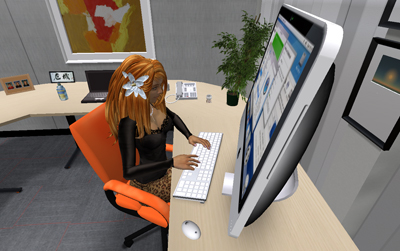Sorry! This was, naturally, my April Fools prank for 2009 🙂
 For some time we have speculated on the so-called Class 6 servers, whose specifications have been floating around for a long time now, but which Linden Lab had formally denied the existence.
For some time we have speculated on the so-called Class 6 servers, whose specifications have been floating around for a long time now, but which Linden Lab had formally denied the existence.
At the same time, with Linden Lab forging strong alliances with IBM, Intel, Sun, Novell, and even to a degree, with Google (which powers the in-world search through a Google Appliance Server), a notable absence has been felt: Apple. Rumours even claim that Steve Jobs has once commented that Apple would never be in Second Life, “because there is no money in it”.
Things definitely have changed. In a recent interview, Linden Lab’s Frank Ambrose, Senior VP Global Technology, and Joe Miller, VP Platform & Technology Development, jointly announced their plans for the new infrastructure that will be supporting the newest generation of Second Life simulators.
Data centres are usually ugly piles of cables all over the place, with  a mess of different hardware solutions, all untidily arranged, forced to fit on racks or enclosures where they were never meant to fit. All data centres usually start neatly and pretty much organised; however, as time passes, new servers are placed on the old racks, which won’t fit in the same space — newer machines are usually slimmer and take less space, though, leaving some gaping holes where you cannot fit machines inside… so it meant opening each rack, taking all servers out, and place them back again, hoping to get things arranged. Doing that while the whole grid is running is always a daunting task, even taking into account that Linden Lab has plenty of spare servers to deal with these kinds of moves.
a mess of different hardware solutions, all untidily arranged, forced to fit on racks or enclosures where they were never meant to fit. All data centres usually start neatly and pretty much organised; however, as time passes, new servers are placed on the old racks, which won’t fit in the same space — newer machines are usually slimmer and take less space, though, leaving some gaping holes where you cannot fit machines inside… so it meant opening each rack, taking all servers out, and place them back again, hoping to get things arranged. Doing that while the whole grid is running is always a daunting task, even taking into account that Linden Lab has plenty of spare servers to deal with these kinds of moves.
Linden Lab has gone through 5 different technology platforms — from Class 1 to Class 5 — and you can very well imagine that each time things get more and more messy, specially because LL buys all their servers and doesn’t lease them. Obsolete servers pile up on corners, but are still used for test grids or low-usage services. No wonder, though, that after a decade of operations a new solution needed to be implemented, to accommodate future changes, while at the same time increasing rack density — which will save LL precious money on co-location bills.
So the solution seemed to be obvious. You needed a class of servers that is fast enough to deal with the current demands of the simulator software. They had to be small — very small! — to allow more servers per rack. They have to be low powered (power is expensive on data servers!). They have to be easily replaceable. They have to be easily configurable. They have to run a variation of Unix. And finally, they ought to be insanely cheap.
If you’re reading all those requirements, the solution seems to be immediately obvious: just use Mac minis.
 Mac fanatics have been impressed with the latest specs of the Mac mini. It’s not an underpowered “gadget” any more. It has pretty much up-to-date hardware, with decent enough performance. It’s infinitely easy to stack them! In fact, one typical 1U-server is about four times the size of a Mac mini — and Class 5 servers, for instance, have about the same performance of a Mac mini. So that means that on a typical rack, that might have 42 servers (running 160 or so sims), you can place 160 Mac minis and run 640 sims! An amazing density increase!
Mac fanatics have been impressed with the latest specs of the Mac mini. It’s not an underpowered “gadget” any more. It has pretty much up-to-date hardware, with decent enough performance. It’s infinitely easy to stack them! In fact, one typical 1U-server is about four times the size of a Mac mini — and Class 5 servers, for instance, have about the same performance of a Mac mini. So that means that on a typical rack, that might have 42 servers (running 160 or so sims), you can place 160 Mac minis and run 640 sims! An amazing density increase!
Mac minis also cost about a tenth of a typical server. What that means for land costs is up to anyone’s guess, but I would expect tier to fall dramatically.
And, of course, Mac minis are easily replaceable, and available anywhere. No need to wait long to get a spare part. Alas, they’re so cheap, that when one goes down, it’s probably easier to enter the nearest Apple store and get another replacement. No need for expensive maintenance contracts for on-location replacements.
Don’t be skeptical about the Mac mini’s ability to run as a server. System administrators are doing that all over the world — mostly because it’s small, compact, low-powered, and easy to transport, and, of course, it’s a full-blown Unix machine with all abilities demanded by modern servers. There are a lot of webpages describing how to use Mac minis as servers for your internal network. It might be the coolest-looking servers out there, although several customers might be unimpressed about such a small gadget that can efficiently replace clusters of outdated iron boxes cluttering the data centre.
All in all, it’s a huge move. Apple, of course, is announcing that Linden Lab will be running the largest cloud computing grid on the world using their hardware — good PR for both companies. And we can definitely expect Apple’s engineers to help out Linden Lab and work with them closely.
“This doesn’t mean we will abandon PCs altogether,” claims Joe Miller on the interview. “Thanks to Philip’s new initiative, independent developers will continue to be able to patch the old Windows code of the SL client and Linden Lab will always offer it for download. Of course, Mac users might expect the main viewer — which will be Mac-only — to improve dramatically from now on”.
Frank Ambrose is even more enthusiastic: “Complex environments like Second Life Grid® often require a complete change of perspective to keep running efficiently. Thanks to several key improvements that are available on Mac OS X — like using Bonjour for peer-to-peer networking among Macs, or Time Machine to deal with immediate backups — SL residents on their Macs will see huge benefits from connecting to regions hosted on Mac minis. They will able to share bandwidth and use peer-to-peer downloading of textures with any other Mac user logged in to the same region. Thanks to Time Machine, we can also be sure that no prims or no inventory will ever be lost again.”
An Apple official has also been rumoured to claim that Apple will start offering direct downloads for SL from their site (and integrate it on the Software Update facility). “However, Second Life won’t be available yet on Snow Leopard’s first release, but probably come bundled on a future upgrade.” Having such strong support of the world’s most used virtual world on the Mac, it’s nice to see Apple so supportive for a change.
What if you’re a die-hard Windows user? Well, you’re not completely out of luck, of course. As said, Linden Lab will continue to develop the Windows version, and independent developers, most of which run Windows, will continue to submit patches. Also, even without the nifty features that the new SL client will bring to Mac users, Class 6 servers will still be faster — even for Windows users — and anyone having land on a sim hosted there will obviously benefit from Time Machine’s “constant backup” mechanism. So, all in all, non-Mac users will also be happy about the change.
And now we can start to speculate about the tier changes… will they go dramatically down?




